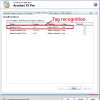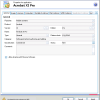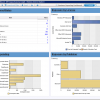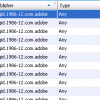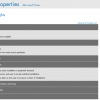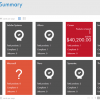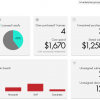Flexera Flexnet Manager for Adobe License Management
This review of Flexnet Manager for Adobe is part of our Adobe License Management feature.
Flexera Commercial Summary
| Product Name | FlexNet Manager for Adobe |
| Product Version Reviewed | 9.2 |
| Version Release Date | December 2012 |
| Year Company Founded & Turnover | 1987 (Installshield), not disclosed |
| Customers | 600 |
| Pricing | Not disclosed |
Flexnet Manager for Adobe License Management
Flexera Software’s key competitive differentiator for managing Adobe Licensing is their product use rights library that encapsulates the license entitlements provided by Adobe. Other competitive differentiators include Flexera’s discovery, inventory and Application Recognition Library that includes the ability to collect and utilize ISO tags for Adobe software identification and suite recognition. ISO tags can also be used to validate inventory sources for Adobe software. (See this article for further details). In addition, their SKU library of more than 600,000 software part numbers, including 30,000 Adobe SKUs allows automated purchase order processing and reconciliation between licenses purchased and installed software.
The use rights for Adobe will vary according to the product purchased and the license mechanism used to procure it. Flexera helps navigate this myriad of potential options by linking use rights to specific versions via a SKU catalogue.
I have written before about harnessing the value of software SKU catalogues. By identifying the specific product use rights relevant to each individual software line item you have purchased (Only really possible by using a SKU), organizations can fully utilize every product use right available to them.
There are specific Adobe product use rights that Flexera exploits, including the following:
- Upgrade Rights – with the right license program, Adobe customers can upgrade to the latest version when it becomes available (Except Adobe Creative Cloud).
- Downgrade Rights – Adobe customers have the right to use a version of the software older than the one purchased.
- Second Use Policy or Portable Use Policy – Adobe allows customers to use an application on a user’s second device – for example a work and home PC. (Does not apply to dual boot machines or mixed operating systems).
- Multiple copies on the same device – Adobe allows multiple versions of the same application on one device. So several different versions might be installed and only consume one license.
By taking advantage of each and every one of these rights, and verifying their entitlement against procurement records via the SKU, a Software Asset Manager can squeeze every last drop of value from Adobe investments whilst also mitigating their compliance risk.
Minimising compliance risk is not just about counting installations on endpoint devices, but also requires an understanding virtual delivery models such as virtual desktops and application virtualization. The way Flexera calculates license consumption includes not only physical installations but also these virtual delivery models. This requires the ability to collect data from access control lists (ACL) and usage data, if available, from the virtualization server (e.g. Microsoft App-V, Citrix XenApp and XenDesktop servers).
SKU data from purchasing is captured during the import process and linked to installs to ensure exactly the right product use rights are used. Flexera then goes to work to ensure these are used to full capacity and the customer is in their optimal position.
This approach might seem like licensing nit picking with no obvious business value – but taking advantage of these product use rights can significantly reduce the amount of licensing required. Even a small proportion of users in an estate using Adobe on a second device and a handful of users with multiple copies on the same device can make a big impact.
Similarly, organizations that find themselves with an Adobe shortfall or a mishmash of the wrong installs for the wrong licenses – can take advantage of upgrade and downgrade to reduce their exposure.
In addition to the Adobe discovery and recognition features above, FlexNet Manager for Adobe also provides management of Adobe Contracts and advanced reporting and trend analysis.
Screenshots
This review of Flexnet Manager for Adobe is part of our Adobe License Management feature.
Links & Further Resources
- Flexnet Manager for Adobe Product Page
- Flexnet Manager for Adobe Data Sheet
- Whitepaper: ‘What does it take to achieve Software License Optimization?’
- Contact Flexera Software
DISCLAIMER, SCOPE & LIMITATIONS
The information contained in this review is based on sources and information believed to be accurate as of the time it was created. Therefore, the completeness and current accuracy of the information provided cannot be guaranteed. Readers should therefore use the contents of this review as a general guideline and not as the ultimate source of truth.
Similarly, this review is not based on rigorous and exhaustive technical study. The ITAM Review recommends that readers complete a thorough live evaluation before investing in technology.
This is a paid review. That is, the vendors included in this review paid to participate in exchange for all results and analysis being published free of charge without registration. For further information please read the ‘Group Tests’ section on our Disclosure page.
About Martin Thompson
Martin is also the founder of ITAM Forum, a not-for-profit trade body for the ITAM industry created to raise the profile of the profession and bring an organisational certification to market. On a voluntary basis Martin is a contributor to ISO WG21 which develops the ITAM International Standard ISO/IEC 19770.
He is also the author of the book "Practical ITAM - The essential guide for IT Asset Managers", a book that describes how to get started and make a difference in the field of IT Asset Management. In addition, Martin developed the PITAM training course and certification.
Prior to founding the ITAM Review in 2008 Martin worked for Centennial Software (Ivanti), Silicon Graphics, CA Technologies and Computer 2000 (Tech Data).
When not working, Martin likes to Ski, Hike, Motorbike and spend time with his young family.
Connect with Martin on LinkedIn.

